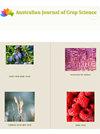Productive characteristics and economic analysis of tropical forage grasses cultivated under different sowing methods in intercropping production systems
Q3 Agricultural and Biological Sciences
引用次数: 1
Abstract
This study aimed to evaluate sowing methods of different tropical grasses in integrated production systems on morphogenic and structural characteristics, chemical composition, and corn yield. The experiment was carried out in a completely randomized design, with a 3 x 3 + 1 factorial arrangement, with three forages: andropogon grass (Andropogon gayanus Kunth cv. Planaltina), massai grass (Megathyrsus maximum cv. Massai) and ruziziensis grass (Urochloa ruziziensis), three ways of sowing intercropped with corn (one row, two rows and broadcast) with four replications and corn in monoculture. Soil preparation, corrective practices and monitoring were carried out as recommended by the species. The results revealed that the sowing methods did not interfere with the interaction for morphogenic and structural characteristics of the grasses. Leaf elongation rate (LER) did not differ among grasses and sowing forms for Andropogon, Massai, and Ruziziensis grasses. There was an interaction effect (P<0.05) for leaf production (LP); the massai grass exhibited higher production compared to other grasses. The spread sowing method produced less leaf availability for the massai grass. There was no effect (P>0.05) of interaction for the variables of the chemical composition of grasses. Maize production was not altered due to the different consortia; however, a much lower value was found when producing corn in monoculture. The average production of intercropped corn was 3420 kg and ha-1, against 1680 kg of single cultivated corn. Massai grass and Ruziziensis grass is an attractive alternative for intercropping with corn in integrated systems间作不同播种方式下热带牧草生产特性及经济分析
本研究旨在评价不同热带禾本科作物在综合生产系统中的播种方式对其形态结构特征、化学成分和玉米产量的影响。试验采用3 × 3 + 1因子全随机设计,选用3种饲料:雄脚草(andropogon gayanus Kunth cv.);芭蕉属(Planaltina),马尾草(Megathyrsus maximum cv。马塞草(masai)和ruziziensis (Urochloa ruziziensis),三种玉米间作方式(一行,两行和撒播),四次重复和玉米单作。根据该物种的建议进行了土壤准备,纠正措施和监测。结果表明,不同的播种方式对禾草的形态和结构特征的相互作用没有干扰。雄草、马塞草和芦孜草的叶片伸长率在不同的禾种和不同的播种方式下没有差异。禾草化学成分各变量之间存在互作效应(P0.05)。玉米产量没有因不同的组合而改变;然而,在单作玉米生产中发现的值要低得多。间作玉米的平均产量为3420公斤/公顷,单作玉米的平均产量为1680公斤/公顷。马塞草和鲁孜草是一种有吸引力的玉米间作组合作物
本文章由计算机程序翻译,如有差异,请以英文原文为准。
求助全文
约1分钟内获得全文
求助全文
来源期刊

Australian Journal of Crop Science
农林科学-农艺学
CiteScore
1.20
自引率
0.00%
发文量
75
审稿时长
3.5 months
期刊介绍:
Information not localized
 求助内容:
求助内容: 应助结果提醒方式:
应助结果提醒方式:


